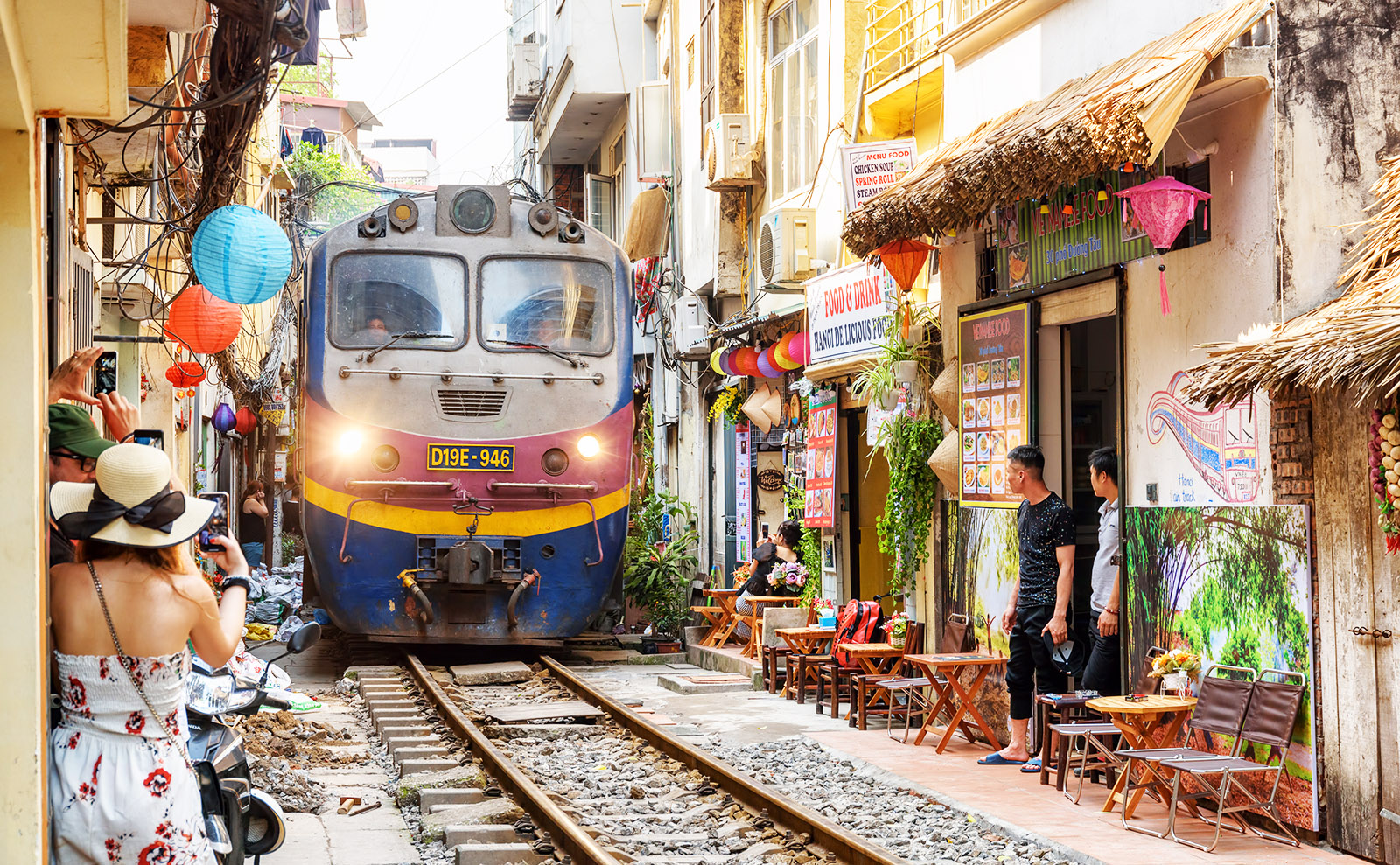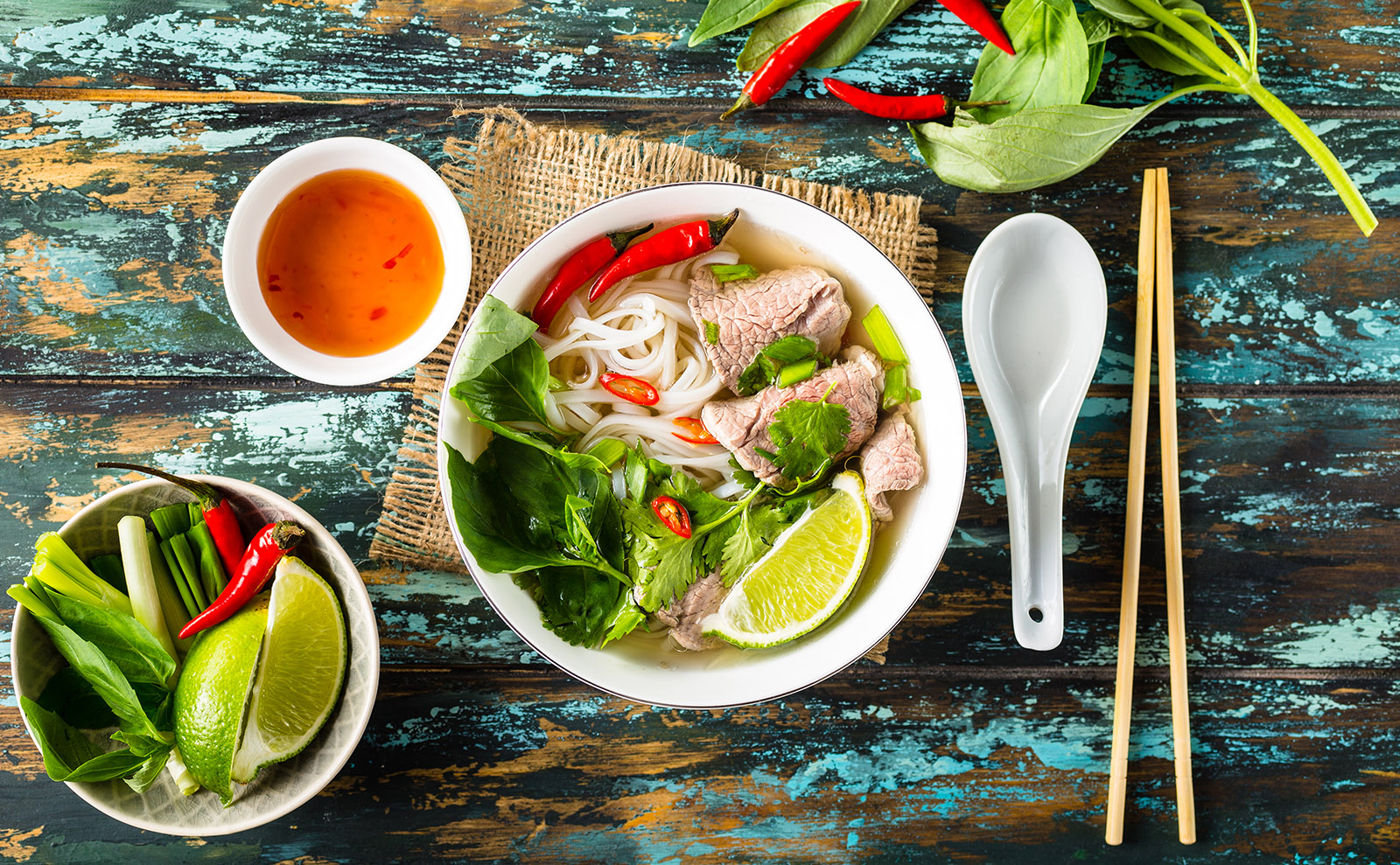
Armchair travel around the world!
Start your reading adventures with our FREE Reading Atlas.

- Around the World in 14 Books
- 7 Thrilling Book Series
- 6 Audiobooks That Are Like Theater For Your Ears



Food and drinks are some of the easiest ways — and the most fun— to vicariously experience another culture. When you add a great book to the mix, you've got the makings of a perfect evening. In Food+Fiction, we recommend a delicious read and a related recipe so you can try the taste of different destinations in your own kitchen.
This post is part of our Food+Fiction series.

In the charming and affecting novel The Beauty of Humanity Movement, Old Man Hung’s pho bo is legendary in Hanoi. The perfectly balanced bowl of broth and noodles represents everything that’s valued by Hung and his culture: dignity and attention to detail, a connection to the past, the importance of community, and the courage to care for the people around you.
As Hung drags his soup cart around the 2007 version of the city he’s called home for decades, he (and we) explore his memories of Hanoi’s days past — of dissidents and love affairs, war and poverty, hope and friendship. It’s a beautiful story, well told, about people with whom you’ll be happy to spend your time.
So put a pot on to simmer and get to know Hung, his young friend Tu, and Maggie, the Vietnamese-American girl that will send all of them on a quest to solve a mystery from the past.
The ingredients in pho bo are simplicity itself: broth, rice noodles, meat, and handfuls of fresh herbs. But when they come together, it’s like fireworks of happiness in your mouth. Pho is considered Vietnam’s national dish and is served just about everywhere in the country — home kitchens, street stalls, upscale restaurants, and greasy spoons.
It originated in the early 20th-century in northern Vietnam, and the styles of pho in Hanoi (north) and Saigon (south) differ. Someone eating your soup would immediately be able to identify where you were from based on the width of the rice noodles, the sweetness of the broth, and the herbs that dot the top of the bowl.
During the ‘subsidy period’ after the Vietnam War, pho shops owned by the state served meatless soup called ‘pilotless pho,’ in blackly-humorous reference to the unmanned drones of the US Air Force. Soup vendors were forced to lower their standards and get creative with their pho during this time of food shortages and strife. (Old Man Hung’s approach to this problem in the novel is ingenious, endearing, and heart-rending.)
Unlike Hung’s approach, this recipe takes the easy way along the path from ingredients to soup. It’s shockingly easy to make and infused with layers of flavor that flirt with all five tastes: spicy, sour, bitter, salty, and sweet. Pho bo includes thin slices of beef, but you can replace the beef with thinly-sliced chicken breast to make pho ga if you prefer.
One final note: Loud slurping is very heartily encouraged.

Serves 2-4. Total time: about 1 hour.
Soak the noodles. Place the noodles in a large bowl and cover with hot water. Allow to soak while you prep the rest of the soup.
Cook the broth. Combine the stock, star anise, cinnamon, ginger, onion, and garlic in a large saucepan. Bring to a boil over high heat, then reduce heat to low and cover. Let it cook, undisturbed, for 20-60 minutes. The longer you cook it, the deeper the flavor! Strain out the solids and return the broth to the pot. Increase the heat to medium-high.
Cook the noodles. Bring a large pot of salted water to a boil. Drain the noodles, add them to the pot, and boil for 30 seconds, then drain well.
Cook the meat. Add the sliced beef to the broth, stir once, then turn off the heat and cover the pan. The meat will cook quickly; about 2-4 minutes is all it takes. Add the fish sauce and some ground black pepper to the pot. Taste and add more salt and pepper, if you like.
Assemble! Add slices of beef on top of the noodles and ladle broth over the whole shebang. Let each diner customize their bowls with lime, scallions, chiles, and herbs; the more greenery, the merrier.
Pssst… read more on the history of pho.
That photo of the train above was taken in Ngõ 224 Lê Duẩn. Known as ‘The Train Street,’ it’s found in the Old Quarter of Hanoi, Vietnam. Twice a day — at 3:00 and 7:00 p.m. — the train between Hanoi and Ho Chi Minh City passes through. Residents often sit on the tracks during the day, drinking tea and playing checkers. When the train comes, they have to move their stuff — chairs, bikes, kids — to allow the train to pass safely through.
The history of Vietnam lies in this bowl, for it is in Hanoi, the Vietnamese heart, that pho was born, a combination of the rice noodles that predominated after a thousand years of Chinese occupation and the taste for beef the Vietnamese acquired under the French, who turned their cows away from ploughs and into bifteck and pot-au-feu. The name of their national soup is pronounced like this French word for fire, as Hng’s Uncle Chin explained to him long ago. ‘We’re a clever people,’ his uncle had said. ‘We took the best the occupiers had to offer and made it our own. Fish sauce is the key — in matters of soup and well beyond. Even romance, some people say.’ — Camilla Gibb
This lovely story of found family features four main characters who will steal your heart: a much-beloved soup maker, his dear young friend, a sassy young woman of Vietnamese-American heritage, and the quintessential Vietnamese comfort food known as pho. The beating heart of the novel is Old Man Hung. He’s an adored and respected soup maker, and his pho is legendary. His broth, the noodles, the perfectly-cooked beef; people depend on his soup (and the associated news and gossip sharing) to start their day. But we soon learn that there’s more to Old Man Hung than his broth. And his past holds the key to the present. {more}
This story of pho and family (320 pages) was published in March of 2011 by Penguin Press. The book takes you to modern Vietnam. Melissa read The Beauty of Humanity Movement and loved it; it wouldn't be on our site if she didn't recommend it.
Bookshop.org is an online bookstore with a mission to financially support independent bookstores and give back to the book community.
Top image courtesy of Efired/Shutterstock.
Want to keep up with our book-related adventures? Sign up for our newsletter!
Can you help us? If you like this article, share it your friends!
Strong Sense of Place is a website and podcast dedicated to literary travel and books we love. Reading good books increases empathy. Empathy is good for all of us and the amazing world we inhabit.
Strong Sense of Place is a listener-supported podcast. If you like the work we do, you can help make it happen by joining our Patreon! That'll unlock bonus content for you, too — including Mel's secret book reviews and Dave's behind-the-scenes notes for the latest Two Truths and a Lie.
Join our Substack to get our FREE newsletter with podcast updates and behind-the-scenes info — and join in fun chats about books and travel with other lovely readers.

We'll share enough detail to help you decide if a book is for you, but we'll never ruin plot twists or give away the ending.
Content on this site is ©2025 by Smudge Publishing, unless otherwise noted. Peace be with you, person who reads the small type.